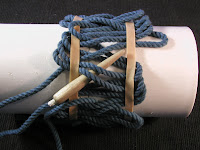
7.1 The finished bracelet worked up to an even tension.
pre-made herringbone rope bracelets are available in these online shops:
WhatKnotShop on Etsy
WhatKnotShop on Zibbet
start over
7.2 The loose ends have been left in place.
7.3 Edge view shows the paired strands and the over two-under two pattern.
7.4 Ready to be stitched and trimmed.
pre-made herringbone rope bracelets are available in these online shops:
WhatKnotShop on Etsy
WhatKnotShop on Zibbet
start over



























